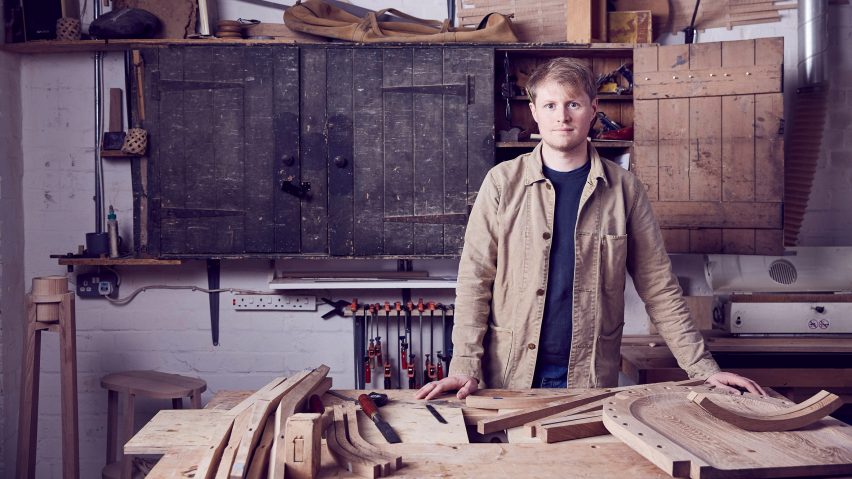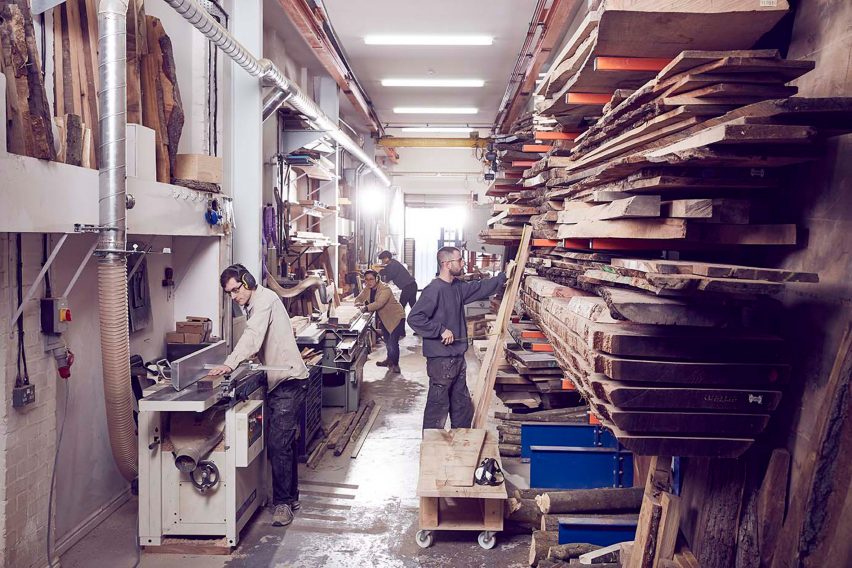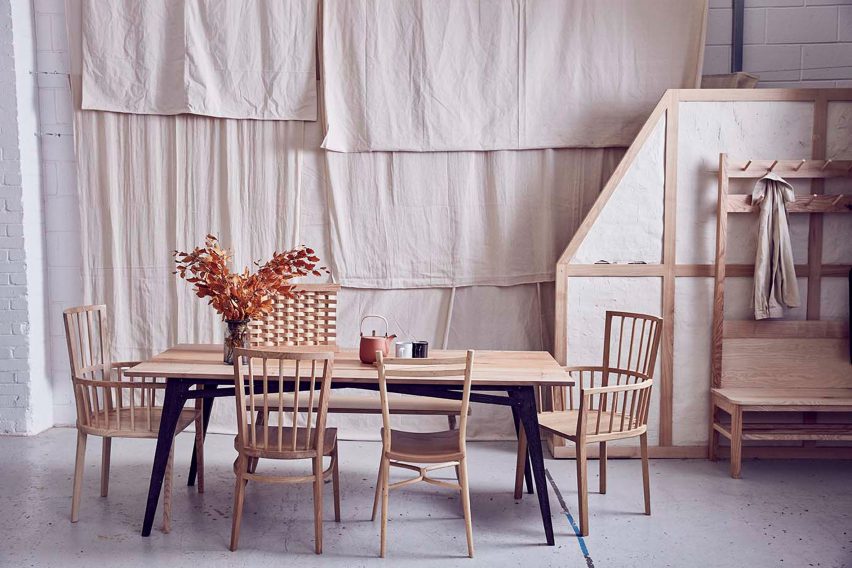
"We are already carbon negative by some long stretch" says furniture maker Sebastian Cox
Creating furniture from locally sourced wood has allowed Sebastian Cox to make his company and his employees carbon negative, the British designer claims.
Last year, Cox stored 100 tonnes of carbon dioxide in timber products such as furniture, kitchens and treehouses, he calculates. Now, he's on track to "smash" this record in 2021.
"As a company, we emit far less than 100 tonnes," Cox told Dezeen. "So we are already carbon negative by some long stretch, to the point that we're taking responsibility for our staff's carbon footprint, too."
Cox takes a holistic approach to design, taking time to understand his raw materials in a way that is both philosophical and scientific. In an opinion column for Dezeen published as part of our carbon revolution series, he imagined how a tree would view climate change.

"They would surely be enjoying the extra CO2 in the atmosphere, which increases their mass," he wrote, adding that the discovery of fossil fuels was a blessing for them as this "saved millions of acres of temperate forest since our prime energy source switched from land-hungry wood to buried fossil energy".
He went on to describe the principle of hygroscopy by which carbon in the soil can help water retention, which helps woodlands stay cool and fertile.
Cox sees atmospheric carbon as "a resource to regenerate our earth"
"For every one gram of extra carbon in soils, eight grams of extra water can be held there too because of the complex hygroscopic structure of soil carbon," he wrote.
"The design community should be leading the material world into an intense period of re-greening and cooling our planet, and it should start by finding ways to make the excess carbon we have in our skies a resource to be used to regenerate our earth."
Like all plant matter, wood is 50 per cent carbon once the water content has been removed. Like furniture maker Takt and shoe brand Allbirds, Cox has created a lifecycle calculator for estimating the amount of the element that is both stored and emitted by his supply chain and the small London workshop where he employs 12 people.
He has also created a carbon counting spreadsheet for his staff, encouraging them to estimate and reduce the annual emissions they generate in their private lives through everything from flying to eating meat.
Using wood can enable designers to get carbon neutral "very quickly"
This year, with the coronavirus pandemic restricting air travel, Cox expects that his products will sequester enough CO2 to offset the emissions generated not just by his business but by his whole team.
"If you employ solid wood, you're going to be getting towards carbon neutral or carbon negative very quickly," he said.
"This is the wonderful thing about wood. It doesn't require heavy heating, you don't have to melt it, you don't have to boil it," Cox continued.
"You've literally got solid carbon that comes in and with a light bit of working becomes a useful product."
Cox, who founded his studio and workshop in 2010, creates furniture using timber from his own managed woodland in Kent.
The 4.5-acre forest is never cut down faster than it can regenerate itself in order to preserve it as a carbon sink and a refuge for wildlife. Cox bolsters his supply with wood from other sustainably managed forests in the south of England.
By turning this wood into durable, modern heirlooms, the designer hopes to store the carbon that was sequestered by the trees for generations to come, as well as highlighting the untapped potential lying in the UK's 3.2 million acres of forest.
More than 40 per cent of this area is neglected and unmanaged, while 87 per cent of the timber used in the country is imported.
"We need to put commercial value in woodlands"
Commercialising and maintaining these forests through techniques such as coppicing, in which trees are cut close to the base to encourage rapid regrowth while encouraging biodiversity by allowing light to reach the forest floor, would allow them to grow faster and lock away more carbon as well as creating a potential economic benefit of £20 million a year.
"We need to put commercial value in woodlands and therefore give a financial incentive for managing them," Cox said.
"For me, it's not about saying: we've got this bit of land that is now sequestering carbon for us, let's lock it up and throw away the key," he continued.
"It's about saying: we're going to allocate this land to biodiversity and carbon services. Now, what else can we do with it without disrupting those cycles?"

Cox was able to create his life cycle calculator purely based on his own electricity bills and numbers he found in online databases, mitigating the cost of working with an external screening company, which can be prohibitive for a small business.
"Most of the information I've got is just from extensive googling," he said.
"I wanted to create something that was entirely self-led, based on research and a spreadsheet, which I adapt as new data is released."
Carbon stored by trees "can vary so much"
Although this means the final figures aren't independently verified, the designer says they help to provide his studio with a workable estimate.
"It's very much guesswork because we're learning now that the carbon stored by different trees can vary so much depending on the amount of water they had access to," Cox said.
"It can fluctuate a lot but we put in a fairly conservative middle-ground figure."
Most of the company's emissions come from drying the wood and transporting it to the London workshop via lorry.
Cox has already managed to reduce this figure by weaning the timber yards he works with off of red diesel, which is a subsidised, dirtier form of the fossil fuel used by off-road vehicles. Instead, he sends them waste sawdust from his workshop to heat the kilns that dry the wood at around 70 degrees Celsius "like a very cool oven".
"The lorry that comes with the wood also takes our sawdust away," Cox explained. "The drying of the wood is carbon neutral because we're drying it with a waste product. We are obviously releasing that waste as carbon but it's not from a fossil source."
The remaining emissions can largely be traced back to the energy needed to power the workshop itself.
Currently, this comes from non-renewable sources via the energy grid as Cox's studio is part of the larger Thames Side Studios industrial estate, where the landlord claims tariffs can't be changed for individual tenants.
Cox uses "very low energy machinery"
But according to the designer, the carbon stored in the wood still cancels out the associated emissions, as for every kilogram of CO2 his machines emit, another eight are stored in the timber they are processing.
"We use very, very low energy machinery to process the wood into furniture," he said. "And if you're working with solid wood, three-quarters of the material never gets worked or machined."
"There's some carbon tied up in things like screws and glue," Cox added. "But really, that's relatively small because the majority of the material we use is wood."
Sebastian Cox is also in the process of becoming certified as a B Corporation, which involves undertaking an extensive self-assessment of the company's impact on the environment, the community and its workers.
"They make you turn around to your suppliers and your customers to say: 'We're making changes. What can you do?'" Cox explained.
"I think that sort of give-and-take relationship is really essential."

Carbon revolution
This article is part of Dezeen's carbon revolution series, which explores how this miracle material could be removed from the atmosphere and put to use on earth. Read all the content at: www.dezeen.com/carbon.
The sky photograph used in the carbon revolution graphic is by Taylor van Riper via Unsplash.